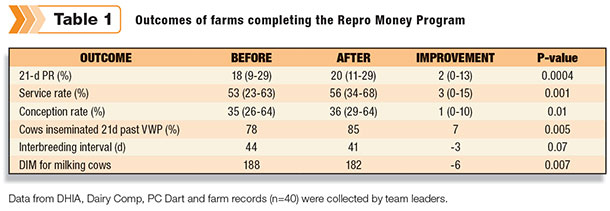What if you could improve your dairy’s 21-day pregnancy rate simply by taking the time to hold a bi-monthly team meeting? That is what happened to nearly all of the 40 dairies enrolled in the University of Wisconsin’s Repro Money program.
According to coordinator Dr. Connie Cordoba, Repro Money is a farmer-directed, team-based extension program designed to improve reproductive performance and overall herd profitability on Wisconsin dairies. As the grant-funded project comes to a close, she reflects on her observations, including some that she did not expect.
“I was surprised that we had a 2 percent increase in pregnancy rate without any specific changes,” she says.
This improvement among participating herds was not necessarily the result of switching a synchronization protocol or any other specific change; rather, it came about from greater awareness of what was really going on with the reproduction program and communicating that among the dairy’s influential players: owner, manager, key employees, veterinarian, nutritionist and breeder or breeding company representative.
For the majority of the dairies, the Repro Money meetings were the first time these individuals had ever formally sat down together to discuss the herd’s reproduction.
With an extension agent or consultant as a facilitator, Repro Money held four team meetings over the course of several months on each dairy. During these meetings, the teams set goals, created action plans with assignments and reported on their progress. Some were specifically looking to improve pregnancy rate, or at least maintain during heat stress, while others wanted to get a better, more accurate picture of their reproduction status.
“Overall, just to know what is really happening on the dairy can make a difference,” Cordoba explains.
Accountability helps, too. “Ninety percent of the teams did what they were supposed to do,” she adds. For some, that meant watching for heats more often or tail-chalking. Others needed to make a call to their recordkeeping company to set up breeding codes in order to track inseminations off of heat versus timed A.I. Keeping a more accurate count of breedings helped to determine which method was most successful on that particular farm.
Across the board, open communication and better checks and balances made a difference (see Table 1 ). Upon enrollment, the average 21-day pregnancy rate among the 40 herds was 18 percent; by the time they completed the program, that statistic had climbed to 20 percent. The value placed on the 2 percent improvement was $38 per cow, according to UW’s economic analysis tool.

Pregnancy rate wasn’t the only improvement on the dairies.
“The highest increase we had was with service rate,” notes Cordoba.
Here, protocol changes seemed to help. While there was typically a clear plan in place for the first service after calving, few of the dairies had a contingency plan for the subsequent services that may be required to get a cow bred back.
The consequence was longer DIM and delayed second breeding. However, by breeding more aggressively and instituting more frequent pregnancy checks (once per week or every other week compared to once per month), several of the dairies were able to tighten their breeding intervals.
Keeping better records and holding regular team meetings also helped dairies see the impacts of cow health on reproduction.
“They didn’t really see how much fresh cow health affects reproduction until they started recording diseases. This turned out to be one of the weak points to increasing pregnancy rates,” Cordoba says. “But it could be improved by having fresh cow SOPs and having a grasp on postpartum diseases.”
Why meetings are worthwhile
Cordoba is encouraged by the fact that 80 percent of the program participants plan to continue holding regular team meetings. She adds, “Every farm felt the real advantage of being part of a team.”
The sit-down meetings often served a greater purpose than getting team members on the same page. For veterinarians, it empowered them to be more than just a person who shows up on the dairy to do a DA surgery or pregnancy check. Combining their perspective with that of the nutritionist, breeder and farm employees provided a holistic approach as well as a support network.
“What we found is that there are a lot of people that care about the farm and find value in the time spent meeting,” Cordoba says.
Her observations made it clear that a consultant is also a key player on the team.
“I think every farmer needs to take time to sit down with a consultant, whether they be from extension or somewhere else,” she explains. “It’s not only the knowledge, but also the specific role of moderating the team. Having a consultant involved in meetings can really pull everyone together.” PD
PHOTO: Gathering the vet, nutritionist, farm owner, breeder and key employees around a table to set goals, form action plans and follow up on progress proved to be an effective way to improve herd reproduction. Cordoba saw great value in the role of a moderator in these meetings, most often a local extension agent. She notes, “They were instrumental in opening the doors of the farm to me, as they already have a relationship of trust with the farmers.” Photo courtesy of Connie Cordoba.

-
Peggy Coffeen
- Editor
- Progressive Dairyman
- Email Peggy Coffeen








